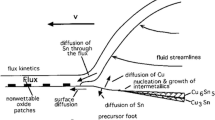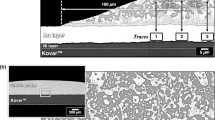Abstract
Solder interconnect reliability is influenced by environmentally imposed loads, solder material properties, and the intermetallics formed within the solder and the metal surfaces to which the solder is bonded. Several lead-free metallurgies are being used for component terminal plating, board pad plating, and solder materials. These metallurgies react together and form intermetallic compounds (IMCs) that affect the metallurgical bond strength and the reliability of solder joint connections. This study evaluates the composition and extent of intermetallic growth in solder joints of ball grid array components for several printed circuit board pad finishes and solder materials. Intermetallic growth during solid state aging at 100°C and 125°C up to 1000 h for two solder alloys, Sn-3.5Ag and Sn-3.0Ag-0.5Cu, was investigated. For Sn-3.5Ag solder, the electroless nickel immersion gold (ENIG) pad finish was found to result in the lowest IMC thickness compared to immersion tin (ImSn), immersion silver (ImAg), and organic solderability preservative (OSP). Due to the brittle nature of the IMC, a lower IMC thickness is generally preferred for optimal solder joint reliability. A lower IMC thickness may make ENIG a desirable finish for long-life applications. Activation energies of IMC growth in solid-state aging were found to be 0.54 ± 0.1 eV for ENIG, 0.91 ± 0.12 eV for ImSn, and 1.03 ± 0.1 eV for ImAg. Cu3Sn and Cu6Sn5 IMCs were found between the solder and the copper pad on boards with the ImSn and ImAg pad finishes. Ternary (Cu,Ni)6Sn5 intermetallics were found for the ENIG pad finish on the board side. On the component side, a ternary IMC layer composed of Ni-Cu-Sn was found. Along with intermetallics, microvoids were observed at the interface between the copper pad and solder, which presents some concern if devices are subject to shock and vibration loading.
Similar content being viewed by others
References
S. Ganesan and M. Pecht, Lead-Free Electronics (New York: Wiley, 2006)
M. Pecht, Y. Fukuda, and S. Rajagopal, IEEE Trans. Electron. Pack. Manuf. 27, 221 (2004). doi:10.1109/TEPM.2004.843150
R. Ciocci, and M. Pecht, Circuit World. 30, 34 (2004). doi:10.1108/03056120410512226
Y. Fukuda, M. Pecht, K. Fukuda, and S. Fukuda, IEEE Trans. Comp. Pack. Tech. 26, 616 (2003). doi:10.1109/TCAPT.2003.817658
Y. Fukuda, P. Casey, and M. Pecht, IEEE Trans. Electron. Pack. Manuf. 67, 305 (2003). doi:10.1109/TEPM.2003.820820
Ministry of Information Industry of the People’s Rebublic of China, “Adminstrative Measure on the Control of Pollution Caused by Electron. Information Products,” March 2006, [Online], http://www.graspllc.com/China%20RoHS.php, Accessed date 04/09/06
“RoHS Regulations: Government Guidance Notes 2007,” URN 07/635, January 2007, [Online], http://www.dti.gov.uk/files/file37219.pdf, Accessed date 04/09/07
Q. Zhang, A. Dasgupta, and P. Haswell (2003) Proc. IPACK03, Int. Electron. Pack. Tech. Conf. and Exhibition (Maui, Hawaii: ASME, 1003), p. 1
G.Y. Li and B.L. Chen, IEEE Trans. Comp., Pack. Tech. 26, 651 (2003). doi:10.1109/TCAPT.2003.817860
Y. Zheng, C. Hillman, and P. McCluskey, Proc. 52nd Electron. Comp. Tech. Conf. (San Diego, CA: IEEE, 2002), 1226 pp
J. Wu, and S. Ganesan, IEEE Trans Comp. Pack. Tech. 28, 166 (2005)
Xu Luhua, J.H.L Pang, H.P. Kithva and T.H. Low, IEEE Trans. Comp., Pack. Tech. 28, 408 (2005). doi:10.1109/TCAPT.2005.853593
T.Y. Lee, W.J. Choi, K.N. Tu, J.W. Jang, S.M. Kuo, J.K. Lin, D.R. Frear, K. Zeng, and J.K. Kivilahti, J. Mater. Res. 17, 291 (2002). doi:10.1557/JMR.2002.0042
K.Y. Lee, L. Ming, D.R. Olsen, W.T. Chen, B.T.C. Tan, and S. Mhaisalkar, Proc. 51st Electron. Comp. Tech. Conf. (Orlando, FL: IEEE, 2001), 478 pp
H. Yu, V. Vuorinen, and J.K. Kivilahti, J. Electron. Mater. 36, 136 (2007). doi:10.1007/s11664-006-0028-x
Tz-Cheng Chiu, K. Zeng, R. Stierman, D. Edwards, and K. Ano, Proc. Electron. Comp. Tech. Conf. (Las Vegas, NV, IEEE, June 2004), 1256 pp
R. Aspandiar, Voids Solder Joints, SMTA J 19, 28 (2006)
J.A. Roepsh, R.F. Champaign and M.R. Downey, J Surf Mount Tech. 15, 19 (2002)
R.J. Coyle, D.E.H. Popps, A. Mawer, D.P. Cullen, G.M. Wenger and P.P. Solan, IEEE Trans. Comp. Pack. Tech. 26, 724 (2003). doi:10.1109/TCAPT.2003.821694
A. Choubey, J. Wu, S. Ganesan, and M. Pecht, Proc. IMAPS Int. Conf. on High Temp. Electron. (Santa Fe, NM: IMAPS, 2006), p. 384
Author information
Authors and Affiliations
Corresponding author
Rights and permissions
About this article
Cite this article
Choubey, A., Yu, H., Osterman, M. et al. Intermetallics Characterization of Lead-Free Solder Joints under Isothermal Aging. J. Electron. Mater. 37, 1130–1138 (2008). https://doi.org/10.1007/s11664-008-0466-8
Received:
Accepted:
Published:
Issue Date:
DOI: https://doi.org/10.1007/s11664-008-0466-8




